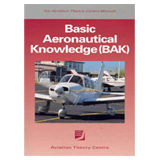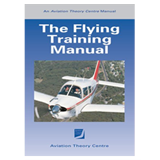[wp_eMember_compact_login]
Straight and Level
Now that you’ve had a little cockpit time and gained a basic understanding of the aircraft’s controls and their effects, it’s time to start learning how to use them to achieve more precise flight
In this lesson, Straight and Level, you’ll learn how to fly the aircraft in a straight line, at a fixed altitude whilst maintaining or changing the airspeed.
Establishing and maintaining Straight and Level flight requires a light hand on the controls, small trim adjustments and a constant eye on the aircraft’s attitude in flight
During your Brief, you’ll learn the following and more:
- Introduction to the aircraft ‘forces’: Lift, Weight, Thrust, Drag
- What is an aircraft ‘attitude’ and how do we use it to achieve S&L
- Aircraft stability. What is it and how stable is your aircraft?
- Techniques to establish and maintain S&L at different power settings
Lesson Techniques
Pilots spend a lot of time flying straight and level, so it’s an important skill to develop early on in your training.
You’ll achieve proficiency faster if you understand the theory behind it, but remember that it takes time and practice to master S&L.
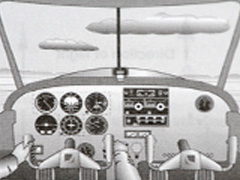
A higher nose attitude. The horizon appears lower in the windshield
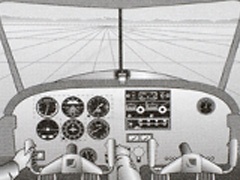
A lower nose attitude. The horizon appears higher in the windshield
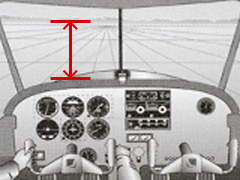
You can accurately set and hold attitudes by remembering the distance between the aircraft’s combing and the horizon
Fortunately for us pilots, it all comes down to the following statement, which you’ll hear countless times during your RPL training:
POWER + ATTITUDE + CONFIGURATION = PERFORMANCE
This essentially means that the amount of power you set with the throttle, combined with a particular aircraft nose attitude will give us a certain performance. That performance could be climbing, descending or flying level (the one we want!).
Simply put, there are different combinations of power and nose attitude that will lead to level flight, easy!
During the lesson you’ll learn about P.A.S.T – setting power(P), then setting attitude(A), waiting for speed to stabilise, then trimming(T) the aircraft to maintain level flight. Try to remember PAT, and be sure to read about it in your text books.
What is an REFERENCE Point?
During this and all future lessons, you’ll be required to fly in a straight line, usually towards a prominent ground feature. Your Instructor will point out ground features and ask you make them your reference point. That is, the point which you’re flying towards.
So what does this look like? Below is an example of a tree being used as an reference point. Notice how the yellow line originates from the centre of the control column and moves vertically up to intersect the tree? Whichever feature is directly above the centre of your control column is your reference point and where the aircraft is heading.
So when you’re asked to fly towards a ground feature, simply manoeuvre the aircraft to position that feature above the centre of the control column, simple!
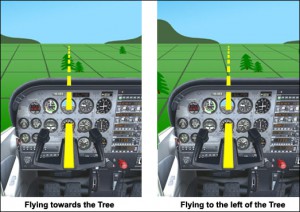
Below is an old video that talks about some of the techniques you’ll learn during this lesson. Enjoy the funky old-school vibe!
Resources
Instructor’s Tips
- The trim control is very sensitive. Moving it just 5mm will make a world of difference
- Lots of small and frequent control adjustments will yield better results than large, less frequent inputs.
- Try and keep your eyes on the horizon when trimming, your ultimate goal is to maintain a specific distance between the nose and horizon.
- hold the controls as if it were an uncapped tube of toothpaste! Don’t squeeze too hard as you’ll find it more difficult to feel if you’ve trimmed correctly
Questions
This section gives you an opportunity to search for information, which is a skill that will come in handy during your training. Use resources such as your text books or the Internet to answer the following questions.
- What is the relationship between Lift and Weight in S&L flight?
- Lift is produced by a combination of ….. and …..
- If an aircraft is travelling at a higher speed, would it require a greater or lesser angle of attack to maintain S&L
- Where is the ‘balance ball’, and what is it used for?
- How many fuel drain points are there on your aircraft?
Learning Objectives
By the end of this Briefing and Flight, you will be expected to be able to:
- Establish and maintain S&L flight at varying airspeeds.
- Use the trim wheel to a high degree of precision
- perform a pre-flight inspection of your aircraft with less assistance from your instructor
- maintain S&L while flap is extended
- understand the 4 forces acting on an aircraft in flight

